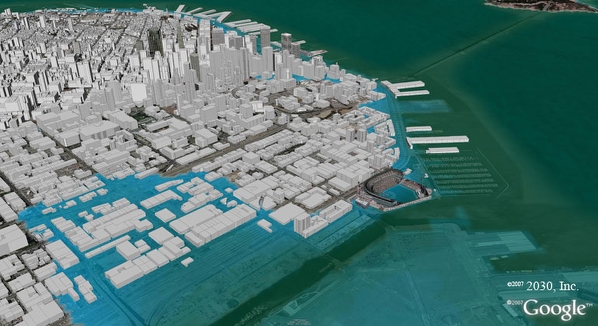Data Points: Urban Futures
• Coastal Impact: What Does Sea Level Rise Look Like?: Architecture2030 gives us a taste of what bad case global warming means for coastal cities in the United States.

• Leaving Home: For a growing number of people, the optimal response to collapsing home value is simply to mail the keys to the bank and walk away.
I calculated that somewhere between 10 million and 20 million U.S. homeowners will owe more on their homes, than their homes will be worth, over the next couple of years.As I've noted before, one of the greatest fears for lenders (and investors in mortgage backed securities) is that it will become socially acceptable for upside down middle class Americans to walk away from their homes. These are homeowners with the "capacity to pay, but have basically just decided not to".
Wachovia is seeing that happen now. Imagine what will happen as house prices fall this year and next.
• Hub2: Prototyping New Urban Environments in Virtual Worlds: Emerson College professor Eric Gordon uses Second Life for "rapid urban prototyping," engaging both designers and stakeholders. (Via Fringehog)
Hub2 employs emerging 3D virtual world technologies to enhance community engagement in the urban planning process. It will enhance the city's current community outreach methods by providing a deeper engagement with the design process and greater accessibility to good ideas emerging from within the community.Hub2 will build a virtual representation of the Greenway to enable non-technical people to design public spaces together. Recent projects like WebLab’s “Listening to the City” dialogues in New York and the Penn’s Landing Forums in Philadelphia all have sought to engage communities in their public spaces. These efforts have shown how to bring together diverse individuals to talk about their shared spaces in an asynchronous web format. The unique contribution of Hub2 is using 3D virtual worlds as a new “language” for having these conversations. Hub2 enables people to communicate their passion for public spaces in a collaborative setting. Participants don’t just talk through ideas – they build their vision in a realistic 3D world. Unlike a 2D or 3D representation, a 3D virtual world allows individuals to inhabit spaces as virtual representations of people who can move through and interact with that space.
• Adam Everyware Greenfield talks Ultradense Cities in Science Fiction: His new book, The City, out real soon now -- I'm really looking forward to it. (Via io9)
The relentless emphasis on high urban density as driver and incubator of pathology I encountered in the SF of my youth now strikes me as more than a little parochial. Much if not most of humanity dwells uncomplicatedly at levels of concentration higher than those the genre routinely depicted as catastrophic - and has for decades. To offer a single developed-nation example: Tokyo’s Shinjuku Station at its sleepiest is about as crowded as the busier sidewalks of Manhattan at peak load, rarely dipping below LOS-D, at least during daytime.And if the high-density favelas and sprawling squatter colonies Robert Neuwirth explores in his impressive Shadow Cities can hardly be said to offer “wholesale hope,” they do at least constitute a surprisingly stable way of life for a billion of us.
• Saudi Arabia: Urban Experimentation in the Heart of Islam: Saudi Arabia tries to get ready for a post-petroleum world.
Drawings of these new towns depict a cross of the futuristic “Blade Runner” and traditional Arabic design. But the new cities are also expected to become new industrial centers that focus on four main sectors: petrochemicals, aluminum, steel and fertilizers.According to SABB, these cities together will have four times the geographical area of Hong Kong, three times the population of Dubai, and an economic output equal to Singapore’s. Other plans include building four refineries, two petrochemical plants and a modern graduate-level university with an endowment of $10 billion.
• SimCity Goes Open Source: Too bad it's the first version, from 25 years ago, but it's a start. (Via BoingBoing)
EA wanted to have the right to approve and QA anything that was shipped with the trademarked name SimCity. But the GPL version will have a different name than SimCity, so people will be allowed to modify and distribute that without having EA QA and approve it. Future versions of SimCity that are included with the OLPC and called SimCity will go through EA for approval, but versions based on the open source Micropolis source code can be distributed anywhere, including the OLPC, under the name Micropolis (or any other name than SimCity).





